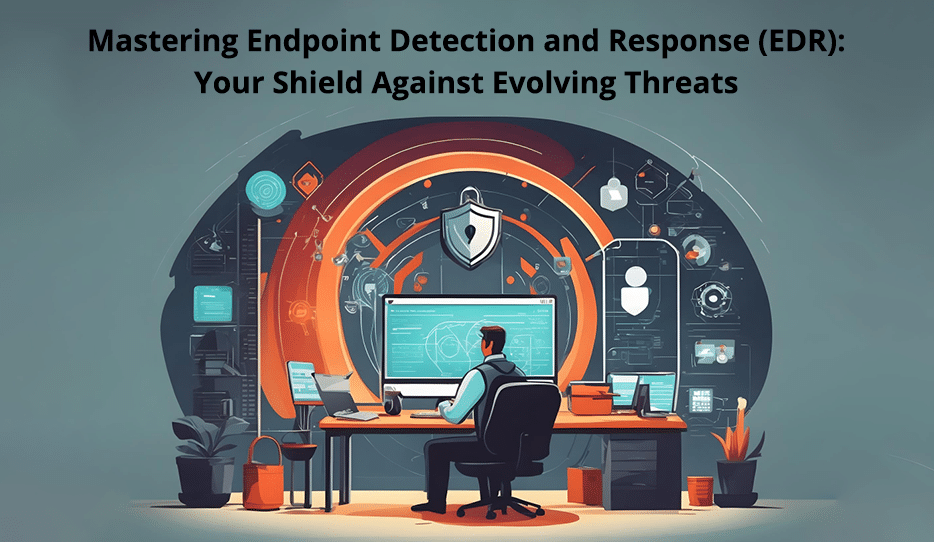
With cyber threats constantly evolving, businesses need cutting-edge solutions to protect their data and operations. Endpoint Detection and Response (EDR) has emerged as a crucial component of modern cyber security strategies, providing a powerful shield against advanced threats.
Understanding EDR
Endpoint Detection and Response (EDR) solutions are the vigilant ‘watchmen’ of your digital environment. They are designed to detect, investigate, and respond to threats across your network, offering insights into the entire lifecycle of a threat. EDR goes beyond mere detection; it provides invaluable information about how a threat infiltrated, where it has been, what it’s currently doing, and most importantly, how to eradicate it. The core principle of EDR is containment: stopping the threat at the endpoint to prevent it from spreading further.
EPP vs. EDR: What Sets Them Apart?
Before diving deeper into EDR’s capabilities, it’s crucial to understand the difference between EDR and Endpoint Protection Platforms (EPP).
While EPP solutions focus primarily on preventing threats at the perimeter, EDR takes a different approach. EDR is designed to detect advanced threats that have already bypassed initial defences and infiltrated your environment. It acknowledges that perimeter defences can’t block 100% of the threats and focuses on swift detection and response.
A comprehensive cyber security strategy often deploys both EPP and EDR capabilities to provide layered protection.
The Power of EDR Security
EDR security becomes your last line of defence against sophisticated threats that elude traditional perimeter defences. Imagine the havoc that ransomware, which encrypts sensitive data and holds it hostage, can wreak on your network. EDR steps in to help you find, contain, and eliminate such threats swiftly, ensuring the security of data on endpoints across your organization.
Why Deploy an EDR Solution?
You might wonder why you should invest in EDR when traditional antivirus and EPP solutions claim to block most threats. The answer lies in the stealthier threats that evade these defences. EDR equips you to detect, investigate, and remediate advanced threats that are sophisticated enough to slip through traditional security measures.
Key Capabilities of EDR
Detection
Detection is the cornerstone of EDR. It acknowledges that advanced threats will inevitably attempt to breach your defences. EDR relies on continuous file analysis to flag suspicious files at the first signs of malicious behavior. Whether a file initially appears safe and later exhibits ransomware activity, EDR detects it, alerts your organization, and initiates the evaluation process.
Threat Intelligence
The effectiveness of EDR depends on the quality of threat intelligence that powers it. Threat intelligence leverages vast datasets, machine learning, and advanced file analysis to detect threats. The stronger your threat intelligence, the more likely your EDR solution is to identify and respond to threats effectively.
Containment
After detecting a malicious file, EDR must swiftly contain the threat. Malicious files aim to infect multiple processes, applications, and users. While segmentation is useful in your data center to prevent lateral movement of threats, EDR goes a step further by containing threats before they can test the boundaries of segmented areas.
Investigation
EDR doesn’t stop at detection and containment; it investigates incidents thoroughly. It uncovers how a threat breached your defences, identifies vulnerabilities, and provides insights to prevent future exploitation. Sandboxing is a critical capability, allowing EDR to isolate and analyze suspicious files in a controlled environment.
Elimination
The ultimate goal of EDR is to eliminate threats. Detecting, containing, and investigating are essential steps, but true security hinges on removal. EDR provides visibility to trace a file’s origins, interactions, and replication, ensuring thorough elimination. Automated remediation based on actionable data is a key feature, restoring systems to their pre-infection state.
Endpoint Detection and Response (EDR) is your organization’s guardian against evolving cyber threats. It complements traditional security measures by focusing on detection, containment, investigation, and elimination. With EDR in your cyber security arsenal, you’re well-equipped to face the ever-changing threat landscape.